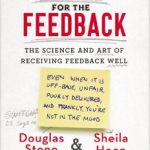 “Keep your eye on the ball and a firm grip on your club” resonates on the fairway on the days that I play golf with my mom. She is a very talented golfer and my game is inconsistent on the best of days. I know that she means well, but I’ll admit that I cringe as I digest her feedback. Fast forward to the local driving range where a friend has agreed to come and watch me break in a new club. Low and behold, he provides the same feedback (almost verbatim) and all of a sudden my reaction is one of gratitude. I immediately put it into practice and voila, that little white ball beautifully sails towards the horizon. Exact same feedback, but my reaction and subsequent implementation varied greatly!
“Keep your eye on the ball and a firm grip on your club” resonates on the fairway on the days that I play golf with my mom. She is a very talented golfer and my game is inconsistent on the best of days. I know that she means well, but I’ll admit that I cringe as I digest her feedback. Fast forward to the local driving range where a friend has agreed to come and watch me break in a new club. Low and behold, he provides the same feedback (almost verbatim) and all of a sudden my reaction is one of gratitude. I immediately put it into practice and voila, that little white ball beautifully sails towards the horizon. Exact same feedback, but my reaction and subsequent implementation varied greatly!
It was on one of those “gotta love this darn game” fairways that I recently had a discussion with a colleague about effective feedback. It wasn’t the usual conversation about how we give feedback, but rather how we accept it. She had attended the Global Leadership Summit sponsored by Willowcreek in August and one of the presenters discussed receiving feedback as his topic.
I started to reflect on this premise on a couple of levels. First my own reaction when receiving feedback. Besides my well-intentioned mom, I receive and actually seek feedback from my supervisors and team members on a regular basis. What factors contribute to my successful implementation of that feedback? Knowledgeable other, respect for the person providing the feedback, shared experience, the way in which the feedback is delivered, the expectation for the implementation, accountability???
When we think about our students and feedback, our most recent practice has been to provide our educators with the tools and strategies to deliver meaningful, timely descriptive feedback. As a profession we are evolving past the “Good Job” and “Gold star” stickers which is creating the conditions for educators to articulate exactly what students need to accomplish in order to move along the learning continuum. The rich dialogue that educators are having both with their students and with each other is having a significant impact on student achievement. Many of our colleagues are also diving head first into the world of pedagogical documentation and using various platforms to document the learning for the purpose of sharing it with colleagues, students and parents as a focal point for discussions about improvement.
So, in the midst of this fantastic feedback frenzy, I can’t help but wonder if we have spent enough (or any) time preparing students on how best to receive feedback. What will it take to ensure that they don’t tune us out?
The other layer of this inquiry is how do we continue to have rich learning dialogues with colleagues knowing the importance of not only providing feedback but receiving it. We are passionate about our practice and take it personally when others comment on what we are doing and how we are doing it. How can we open our ears and hear what others are sharing without becoming defensive?
 Just today, I had a conversation with a colleague in passing and I started to share my new thinking on the topic of feedback. Within minutes, she highly recommended “Thanks for the Feedback” written by Douglas Stone and Sheila Heen. Looks like I’ve just acquired one more book to add to my list of “must reads”!
Just today, I had a conversation with a colleague in passing and I started to share my new thinking on the topic of feedback. Within minutes, she highly recommended “Thanks for the Feedback” written by Douglas Stone and Sheila Heen. Looks like I’ve just acquired one more book to add to my list of “must reads”!
What factors affect how you receive feedback? How can we better prepare both ourselves and our students to effectively receive feedback?
Come write with me…..

I just wanted to agree with the comments already made about the importance of the relationships between the people giving and receiving feedback. One change I have made recently in my own teaching is to ask students if they want coaching or if they want time. I find this puts the child in a power position and often, if they choose coaching, they are more open to feedback.
I also believe in the power of peer feedback. Here too, we need to be aware of the relationship between the students who are working together. BUT, it is often more meaningful to receive feedback from those we see as “equals”. It takes some training, but peer feedback can be very effective.
LInda
Feedback can be a sweet salve or a cutting knife, it can be used to control or used to generate ideas and build positive relationships. I think Sarah (above) hit it when she talked about it all being in the relationship. If the relationship and understanding is there receiving feedback is relatively easy. But add to that “respect” and the whole game changes. Even harsh feedback from a person you respect can be a meaningful and helpful. But I’d also like to add that good and profitable feedback needs to be given (and thereby received) on the right agenda! It’s not that I can’t received feedback regardless of how it’s given, but is it given to suit my agenda or what I”m trying to work on? Or is the person giving the feedback on a whole other track, giving feedback that fits “their” agenda more than mine?
I didn’t read the book nor hear the various speakers on this topic, but was there anything said about receiving the feedback, but then (if the case fits, not just because you feel obstinate) being able to say to the feedback giver – “Thank you, but I feel you totally missed the point of what I’m trying to do here. Your feedback in no ways is helpful and I’m not going to run with those suggestions!” I’m not there yet. I quietly smile, nod my head in acknowledgement, and slip away when I can and just never talk about it again. Kind of passive aggressive like. I much prefer feedback that is in agreement with the project and agenda. Then it’s quite easy to accept whatever comes – positive or negative, because there seems to be a reason to want to make it work for the best possible outcome. Maybe that goes back to relationship again.
Until starting that book this past summer I never realized the importance of looking at ‘how’ to receive feedback and how it can impact how I ‘give’ feedback. I think we all hold our practice so close to our heart that it can be easy to put on a defense as soon as others have a thought to share… but it really is the first step to change; learning to be open to another thought/idea/direction.
I also attended the Summit this summer (live in Willowcreek-what an experience!) and heard Shiela Heen speak. “Thanks for the Feedback” is in my current pile of reading. Receiving feedback is something that’s difficult for me, not because I don’t want to improve, but because I often receive it with my heart instead of my head. Seething I’m working on.
Sue,
The biggest factor for me in how I received feedback is the relationship I have with the person providing the feedback. Is it someone who knows me well? Who understands my perspectives and reasoning? Who respects me as an individual and on a professional level? Do I have the same feelings for them? If not the feedback is harder to take in and implement. I am a firm believer in connections – we must build stronger connections with people in order to best support each other through change and growth. That being said we don’t need to be “besties” and know all the details of each others lives, but we do need to go beyond a superficial connection in order to develop a trust and mutual respect. Without that, the feedback is harder to take.
Sarah
Great post. Recently I have moved to providing descriptive feedback on small notepad paper (specifically the TVDSB notepads from Sys Staff Development). Students see this ‘special’ note stapled to their work, and they are intrigued. They read it like a personal friendly letter, the ones we all used to love to receive in the mail. I watch them, reading it with wonder…and see their appreciation for the time taken to write their note. The feedback is seen more as a gesture. It is customized, just for them. Their name embedded in the message with a sentiment of appreciation and an ‘I Wonder’ message from their teacher. As I pass work-out, the reward is on the excited eyes I see as students race to read the message. What a difference notepad paper can make. I look forward to investigating more about ways we can get S’s to RECEIVE feedback.
As leaders we have a critical role to play in establishing an environment open to dialogue, open to discussion where feedback is part of the daily synergy that drives innovation . We must nurture a safe environment where attempts at what could be done and what is new can happen free of reproach should the predictable failure and setback occur that comes with any new venture. If we preforgive and grant permission to muck things up and see what comes of it we then establish a school where educators are free to stretch and try, to inquire and innovate. Within that environment “next steps” and “what else can be done ” and “how can we make that better” naturally flow from the conversations . Feedback is not an event but in of itself a next and natural step! Be an active part of the inquiry, be part of the conversation and watch it bloom